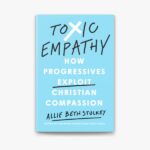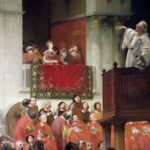 Winfield Bevins is Director of Church Planting at Asbury Seminary. This article is adapted from his new book Ever Ancient Ever New: The Allure of Liturgy for a New Generation.
Winfield Bevins is Director of Church Planting at Asbury Seminary. This article is adapted from his new book Ever Ancient Ever New: The Allure of Liturgy for a New Generation.
In a choose-your-own-religion culture of abounding options, where can young people find something that calls them beyond their own preferences or opinions? What can connect and ground them to a historic faith, one shared by generations past?
I recently interviewed several hundred young adults across the United States for a new book Ever Ancient Ever New: The Allure of Liturgy for a New Generation. Even though the broader trend is somewhat discouraging, there is a growing movement of young adults who are embracing Christian orthodoxy through the historic liturgical tradition, which is encouraging and offers a measure of hope.
In contrast to the modern era with its reliance upon certainty, the postmodern era has all but done away with certainty in favor of plurality and relativism, but this has proven to be an empty pursuit for many. As they encounter the uncertainty and ambiguity of a postmodern world, young people are beginning to look for something to believe in again, something that adds stability to their identity. An orthodox faith offers them this clear, stable foundation. For many, it harkens to another time and is not bound to the biases of today’s culture. One young adult from Chicago told me,
“Liturgy is the opposite of our culture . . . in the sense that it provides ordered participation instead of watching passively. It’s a way for the congregant to own what he or she is doing and saying. We live in an age where our opinions are voiced on social media—where we can read any opinion by typing something in on Google. So in this age, it is refreshing to stand for a faith with our whole being—words and actions.”
Today’s young adults have grown up in an age of political, financial, moral, and global uncertainty. While some are comfortable swimming in the uncertain waters of postmodernity with all of its relativity and flexibility, others have found those waters hazardous to their personal and spiritual health. These young people are searching for truths that transcend their immediate context. They long to be part of something lasting, and many have found that certainty in expressions of the Christian faith that embrace and acknowledge the full scope of church history—a Christian tradition that goes back two thousand years. This is not an uncritical embrace of the past. One young adult said, “I want to affirm what Christians have always believed in every age through a common faith and a common creed.”
Colleen Carroll Campbell is an author, journalist, former presidential speechwriter, and Roman Catholic who has observed this movement since the late 1990s. She won a Phillips Journalism Fellowship, which allowed her to spend a year researching for her book, The New Faithful, a look at why some young adults are embracing Christian orthodoxy. She writes, “Amid the swirl of spiritual, religious, and moral choices that exist in American culture today, many young adults are opting for the tried and true worldview of Christian orthodoxy.”
Campbell’s findings confirm what I have found in my own conversations and interviews with young adults across the country. Young adults are longing for something to believe in and a story to be a part of, and for many, the liturgical tradition provides them with that sense of stability, a solid anchor amidst the uncertainty of their own struggles and the transitions of postmodern culture.
The Important Place of Orthodoxy
Why does orthodoxy matter anyway? What we believe shapes our identity, and ultimately, who we are. Orthodoxy means “right belief,” and for Christianity, a right belief is a belief that agrees with the whole of Scripture and the teachings of Jesus and the apostles. This is especially true regarding the core doctrines of the Trinity and the church. What makes Christian orthodoxy stand apart in our postmodern world is its clear statements of what we believe, and the commitment to hold to these beliefs regardless of the relativism we find in the world. While others may abandon their beliefs for the latest trends, Christians are rooted, holding firm, concrete beliefs about the Triune God: Father, Son, and Holy Spirit.
Our orthodoxy—right beliefs—are important for discipleship because orthodoxy is directly connected to our orthopraxy, our “right action.” The practical application of a belief is an action taken in response to or based on that belief. This is why what we believe about God matters immensely. What we believe about God influences how we think, pray, worship, and, ultimately, how we live. No, we are not all called to be professional theologians, but every Christian has a responsibility to know what they believe for themselves. You can’t worship what you don’t know.
Rather than reinventing the faith, young people are drawn back to the foundational truths of Christianity, back to orthodoxy. I believe every generation of believers must revisit the faith and doctrines of the early church as found in the Holy Scriptures and the historic creeds. In our time, these truths and doctrines sharply contrast with the postmodern mood of our culture, providing a new or young Christian with a substantial foundation upon which to stand. The mission of the church is to engage a changing world with an ancient faith that is relevant and fresh for each generation. It’s about communicating clearly and calling each generation to the solid foundation of historic orthodoxy.
Thousands of young adults are finding a stability and substance for their faith around the orthodoxy articulated in the historic creeds of the church. They are discovering that orthodoxy is not a dry, sterile confession of the faith, but rather a living affirmation of one’s belief in God. What we believe influences who we are and how we live privately, but also socially and environmentally. The recovery of orthodoxy among this generation is a sign of renewal that should give us hopes for the future of the church as it rediscovers its ancient roots.





Comment by RANDALL L BURGESS on June 27, 2019 at 11:46 am
How do you propose that an Orthodox Anglican (APA) congregation best reach out their community for those looking for a liturgical experience?
Although young people are finding us through our website, there is probably more we could do.
Your answer is probably in your book, so I’ll read it.
Comment by David on June 28, 2019 at 11:21 am
Liturgy is definitely out of fashion as mentioned. I suspect churches that offer “contemporary” and “traditional” services are just waiting for us oldsters to pass on. Many select their church not on the basis of doctrine, but rather on what music is being performed. Church has become a form of entertainment. I always found the responsive readings of my youth to be the most dreary part of the service. For years, the Ocean Grove [NJ] Camp Meeting held a communion service daily in their summer season. I was given a copy of their program schedule the other day and this has been eliminated with but a single communion event. Low attendance is the likely cause of this.
The Trinity is probably the modern Christian belief with the flimsiest basis in scripture. There was a great deal of debate over this in the early church. Those who disagreed were branded as heretics and paid the penalty. The Old Testament “the Lord our God is one” is not exactly supportive of this doctrine.
Comment by April User on June 29, 2019 at 9:51 am
And it’s not just young people that have gravitated to a more historic expression of Christian faith and worship. My husband as clergy and I have journeyed from the Assemblies of God to the UMC and now the Anglican Church (ACNA). We love knowing that as we worship on Sundays and observe the Daily Offices that there are millions of others around the world who are affirming the same creeds, prayers, and Scriptures and that the great cloud of witnesses, along with the Church present, sing in endless praise “Holy, holy, holy…”